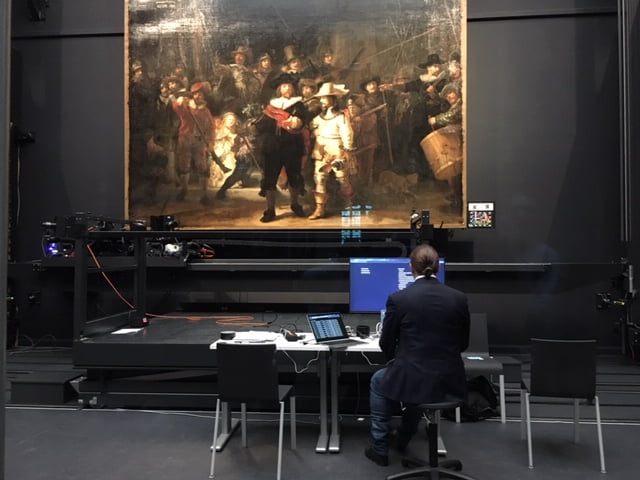Consuming Culture: Can we ever fully understand art without standing in front of it?
September 7, 2020

Under the microscope – Operation Night Watch at the Rijksmuseum (Photo: Anna Cale)
Earlier this year, before the world came to a complete standstill, I was lucky enough to enjoy a weekend in Amsterdam with my best mate. The idea was for us to spend some quality time together without our children, enjoying some art and a few cocktails, and happily we managed to consume a lot of both.
I love Dutch art, mainly of the 17th century variety. I have been to the Netherlands several times, and in each town or city I have visited, I managed to seek out the art galleries and museums to see the work of some of my favourite artists in person. Nothing beats that feeling of walking into a gallery and standing in front of a work that you have longed to see.
The main artistic aim of the trip this time around was to visit the Rijksmuseum again. My friend and I had both been before, but this time we were able to walk around in our own time, without our young children demanding attention or citing boredom. Some of my favourite paintings are there in that magnificent building, and it was a joy to say hello to them again. To just stand in front of the art and absorb it.
The flagship painting in the Rijksmuseum is Rembrandt’s ‘The Night Watch’. It is a magnificent painting. The first time I saw it I sat there for ages, mesmerised. It is a bombastic, bold and brave work, and it is framed as such, with a whole room dedicated to its display and to showcase it in the best way possible. The other paintings in the room complement the work and add context, they help to build the story around it and its inception and backstory. They have created a cleverly curated viewing experience.
This time, however, the painting was going through a period of research and restoration. Instead of taking it away to work on it behind the scenes, the work is being done in public, right there in the gallery. ‘Operation Night Watch’ is a huge research and conservation project. The painting is being studied in forensic detail, scanned, photographed thousands of times and analysed, like a real-time police investigation. The painting is surrounded by a huge glass chamber, but will still be visible to the public throughout the whole project.
Watching the conservationist perform each painstakingly intricate and minute movement of the computer-controlled camera, trapped inside the glass box like it was a huge fish tank, was curiously fascinating. It was an art installation in itself. But it was also a big distraction. I found it captivating as a spectacle, but I was looking at the bloke with the trendy glasses and his multitude of laptops, I was not looking at the painting and having an emotional reaction to it.
But can seeing it in more detail tell us anything more about a painting and how the artist wanted to present it? For me, it is a different way of seeing and understanding, but it removes some of the joy. In theory I was seeing far more of the painting than I could ever wish to, but it was through a lens, and that added a false barrier and took away the relationship aspect of seeing a painting up close.
It felt similar perhaps to those people who go to a gallery and just take photographs of the famous paintings. They stand right up close to them, phone or camera in hand. They see it through the viewfinder of their smartphone, not with their eyes. Maybe they look at it later, on the journey home perhaps. Or maybe they won’t even look at it at all, just post in on social media, or let it sit in their phone’s photo album, mentally ticking it off the list of things they have ‘seen’.
In the Van Gogh museum in Amsterdam, the second gallery visit of our weekend, my friend and I saw three young women taking turns to pose for a selfie in front of a painting. Each in turn, they stood with their back to the painting and posed for a photo. Then they left. Did they even look at it? Art as an Instagram post to be liked by others, but not the person themselves.

A life well-lived – Rembrandt’s final self-portrait painted in 1669 (Photo: Mauritshuis / Wikimedia Commons)
My favourite ever painting, ‘Rembrandt van Rijn, Self-Portrait’, 1669, is in the Mauritshuis in The Hague. I do not know why it is my favourite painting, it just is. I have loved it for years, but I had not seen it for myself, only photographs of it. But then a couple of years ago I had the chance to visit the gallery.
The Mauritshuis is a beautiful space to see art. Their collection is amazing, and the curation of it suits the aesthetic of the historical building so well. It is a place to showcase the small scale, impactful works in the Dutch national collection. Vermeer’s famous ‘Girl with a Pearl Earring’ is also there. Visitors always crowd around her to get a good look. It is a beautiful painting, but I went straight to the work I had wanted to see for so many years, my Rembrandt.
It was just as special as I had hoped. There is so much of a life lived in that painting. The artist died that year, and it was probably one of his last works. Rembrandt’s life story is fascinating, and for me, it is all there, in that painting. There is so much expression in it, he looks like a man who has experienced so much, and you can see it in his eyes. The gallery describes it as Rembrandt showing himself as “a man of flesh and blood” and I would agree.
I cried when I finally stood in front of it. There is feeling of intimacy in the small gallery, as if it was just me and Rembrandt in the room. I looked into his eyes and felt like I really understood the man, as well as the painting. I will never forget that feeling.
Like most people, I have not been able to visit a gallery for several months now, and I really miss the experience. There are other ways to consume art. I have perused my art and photography books. I have watched a few art documentaries, including an in-depth study of a Titian exhibition at The National Gallery from a few years ago. You get to experience it, gain a sense of it perhaps, but it is not the same as being there in the gallery yourself. I am so glad I was able to go to Amsterdam when I did, as it has kept me going in these odd times.
Due to the impressive in-depth analysis taking place at the Rijksmuseum, you can now ‘experience’ the The Night Watch online. You can study it on your computer screen in minute detail and zoom in on every aspect of the painting. It is an amazing technical achievement, and opening up art collections to the world like that will allow more people to appreciate incredible artistic works. But for me, I cannot wait to be in the room with the painting again, getting up close and personal.
You can find out more about ‘Operation Night Watch’ at the Rijksmuseum here
Filed under: Art & Photography
Tagged with: Amsterdam, anna cale, art, conservation, consuming, Culture, digital, gallery, high res, museum van gogh, Netherlands, night watch, online, Operation Night Watch, painting, Rembrandt, Rijksmuseum, selfie



Comments